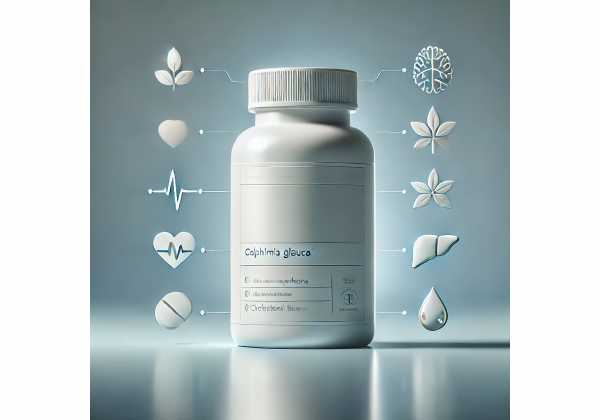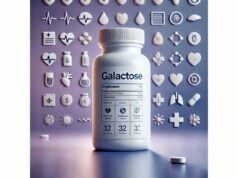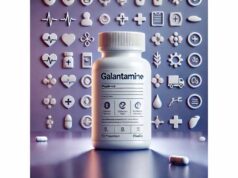
Galphimia glauca—known locally in Mexico as thryallis or “calderona amarilla”—is a small shrub whose golden flowers hide an unusual group of triterpenes called galphimines. Among them, galphimine-B has drawn clinical attention for easing symptoms of generalized and social anxiety without the heavy sedation seen with some conventional medicines. Standardized extracts have been compared with lorazepam and alprazolam in controlled trials, and early data suggest comparable improvements with fewer complaints of daytime sleepiness. Beyond mood, laboratory studies point to anti-inflammatory and antihistamine-like actions that help explain traditional uses for “nervous” and inflammatory complaints. If you’re exploring plant-based options, this guide explains what Galphimia glauca is, what the evidence actually shows, how people use it, dosing approaches used in trials, and who should avoid it.
At-a-Glance
- Standardized Galphimia glauca extracts improved anxiety scores similarly to lorazepam and alprazolam in controlled trials.
- Reported side effects were generally mild; daytime sleepiness occurred less often than with alprazolam.
- Typical study dosing delivered 0.35–0.70 mg galphimine-B per day from standardized capsules.
- Avoid during pregnancy and breastfeeding, and do not combine with sedative drugs without medical supervision.
Table of Contents
- What is Galphimia glauca and does it work?
- Evidence-based benefits you can expect
- How to take it and typical dosage
- Quality, forms, and what to look for
- Safety, interactions, and who should avoid
- What the research says so far
What is Galphimia glauca and does it work?
Galphimia glauca (family Malpighiaceae) is a sun-loving ornamental shrub native to Mexico and parts of Central America. Traditional healers have long used its aerial parts—primarily leaves and stems—as calming teas or tinctures for “nervous” conditions. Modern research isolated a set of modified triterpenes, the galphimines (especially galphimine-B), as the main bioactive constituents responsible for anxiolytic effects. These compounds are unusual: instead of acting chiefly on the GABA system like benzodiazepines, they appear to modulate midbrain dopaminergic neuron activity (notably in the ventral tegmental area) and interact with serotonergic pathways involved in anxiety signaling. That different pharmacology helps explain why standardized extracts may calm without strong motor impairment or rebound effects commonly associated with some sedatives.
Do those mechanisms translate into real-world benefit? Early clinical evidence says “possibly, yes.” In randomized, double-blind studies, standardized Galphimia glauca preparations were compared with well-known anxiolytics. Over 4–15 weeks, participants with generalized anxiety disorder (GAD) taking the plant-based product improved about as much as those on lorazepam and alprazolam on validated anxiety rating scales. A small, controlled pilot in social anxiety disorder found similar symptom reduction compared with sertraline. While these trials were conducted by the same Mexican research network and more independent replication is desirable, they consistently show meaningful symptom relief with favorable tolerability.
A key detail that separates promising botanicals from the rest is standardization. Not all Galphimia plants produce galphimines at useful levels; the presence of galphimines varies by population and even by species in the Galphimia complex. Products used in clinical trials were standardized to a measured galphimine-B content and produced under controlled extraction conditions. That standardization increases reproducibility and likely contributes to the positive outcomes reported.
Beyond anxiety, laboratory studies suggest anti-inflammatory and antihistamine-like actions. Extracts have downregulated inflammatory signaling in cell and animal models, and historical reports describe relief of allergy symptoms—though the robust clinical evidence remains centered on anxiety. For readers weighing whether it “works,” the short answer is that standardized, galphimine-B–containing preparations have shown clinically relevant anxiety reductions, with limitations: most trials are from one region, sample sizes are modest, and long-term outcomes need more study.
Takeaway: Galphimia glauca is not simply a “mild herb.” When standardized, it has a plausible, non-GABAergic mechanism and human data suggesting anxiolytic efficacy. The quality of the extract—especially confirmed galphimine-B content—largely determines whether it works.
Evidence-based benefits you can expect
Generalized anxiety disorder (GAD). In controlled trials enrolling adults meeting diagnostic criteria for GAD, standardized Galphimia glauca capsules produced anxiety score reductions similar to lorazepam (0.5–1 mg) and alprazolam over 4–10 weeks, with continued benefits observed across a longer, 15-week study that included a structured taper. Participants typically began with moderate to severe symptoms (e.g., Hamilton Anxiety Scale scores in the mid-30s) and improved to near-remission ranges by study end. Response rates (≥ 50% reduction) and “therapeutic success” proportions were high in both groups; in one trial, the plant extract numerically outperformed the benzodiazepine comparator. Importantly, daytime sleepiness—a common complaint with benzodiazepines—occurred less frequently with the galphimine-B standardized extract.
Social anxiety disorder. A smaller, double-blind pilot compared a galphimine-B standardized extract with sertraline 50 mg for 10 weeks in young adults. Both groups improved to a similar extent on the Brief Social Phobia Scale and a health status score. While the study was underpowered for equivalence, it suggests potential across anxiety subtypes beyond GAD.
Stress reactivity and calm focus. Preclinical data show that galphimine-B decreases excitatory firing of dopaminergic neurons in midbrain circuits involved in salience and stress appraisal. In practical terms, users often describe “quieting” of somatic anxiety (racing thoughts, restlessness) without feeling dulled. The distinct, non-GABAergic mechanism may preserve motor coordination and reduce risk of tolerance compared with classic sedatives, though this needs longer, head-to-head clinical confirmation.
Inflammation and allergy-related symptoms (supporting evidence). In vitro and animal studies indicate anti-inflammatory activity, including modulation of mediators that participate in allergic responses. Historically, Galphimia glauca has been used for hay fever-like symptoms, and there are older homeopathic studies in seasonal allergic rhinitis; however, these are outside the scope of standardized, pharmacologically active extracts and do not meet current evidence standards. If allergy relief is your primary goal, consider the anxiety benefits a “bonus,” and continue standard care unless your clinician advises otherwise.
Quality-of-life and sleep. While not sleep medication, reduced hyperarousal can improve sleep continuity. In trials, participants on standardized Galphimia glauca reported fewer sedative-type adverse effects than those on alprazolam, and laboratory safety monitoring showed no clinically meaningful liver or kidney changes over study durations. That said, formal sleep metrics were not primary endpoints, so sleep benefits should be considered secondary and person-dependent.
Who might benefit most. The best fit appears to be adults with GAD who want non-benzodiazepine options or who have experienced daytime sedation on conventional agents. People with performance-related social anxiety may also benefit, but the evidence there is preliminary.
Expectations matter. In the clinical studies, improvements built over weeks, not hours. The standardized capsules were taken twice daily, and benefits became evident within the first 1–2 weeks, continuing through weeks 4–10 and longer. If you try Galphimia glauca, commit to a consistent, measured regimen using a standardized product rather than occasional, on-demand use.
How to take it and typical dosage
Forms used in studies. Published trials used oral capsules containing a dry extract of Galphimia glauca standardized to a defined galphimine-B content. The most detailed regimen disclosed capsules with 0.175 mg galphimine-B each, taken one or two capsules twice daily for 12 weeks (plus a 3-week taper). A separate 10-week program used an extract that delivered 0.374 mg galphimine-B per dose once daily. These reveal two practical dosing bands:
- Lower band: ~0.35 mg galphimine-B per day (one 0.175 mg capsule twice daily).
- Upper band: ~0.70 mg galphimine-B per day (two 0.175 mg capsules twice daily) or ~0.374 mg once daily depending on the product.
Choosing a starting dose. If your product clearly labels galphimine-B content, a pragmatic approach is to start at the lower band, assess response after 1–2 weeks, and increase toward the upper band if needed and tolerated. If your label lists only “standardized extract” without galphimine-B micrograms, contact the manufacturer for the assay specification. Without that figure, you cannot reliably match study dosing.
Timing and consistency. Take with water at roughly the same times each day (e.g., morning and early evening). Food is optional; some users prefer with a light meal to minimize queasiness. Because onset is gradual, evaluate progress at weeks 2, 4, and 8 using a simple symptom checklist (worry, restlessness, muscle tension, sleep, concentration). Share those notes with your clinician.
Tapering. In the longest controlled study, participants tapered after 12 weeks by stepping down the capsule count over 3 weeks. While plant extracts are less associated with withdrawal than benzodiazepines, tapering is sensible if you’ve taken higher daily amounts for several months. Reduce dose by ~25–50% every 1–2 weeks while monitoring symptoms.
What about teas or tinctures? Traditional preparations vary in plant part, harvest timing, and extraction strength. Because galphimine-B content is highly variable across populations and not highly water-soluble, teas are unlikely to deliver the standardized microgram amounts used clinically. If you choose non-standardized forms, understand the effect may be mild or inconsistent.
Stacking with other supplements. Combining with sedating botanicals (kava, valerian, passionflower) or magnesium can increase drowsiness. Pairing with stimulating adaptogens (rhodiola) may blunt calming effects in sensitive individuals. When in doubt, use Galphimia glauca alone for 2–4 weeks before layering.
Alcohol and caffeine. Moderate caffeine is fine for most; excess undermines any calming regimen. Avoid alcohol near dosing times until you know your individual response.
Special populations. There is no established dosing for older adults, adolescents, or people with significant hepatic or renal impairment. Start low, go slow, and involve a clinician.
Practical checklist before starting:
- Verify galphimine-B content per capsule or per dose.
- Map your daily total into one of the bands above.
- Plan 4–10 weeks of consistent use before judging.
- Review medications for potential interactions (see Safety section).
Quality, forms, and what to look for
Botanical identity matters. “Galphimia” is a genus with several closely related species and regional variants. Only specific populations produce galphimines at useful levels; misidentification or sourcing from non-producing populations dramatically lowers potency. Responsible manufacturers confirm identity with DNA barcoding or characteristic chromatographic fingerprints and then quantify galphimine-B (and sometimes A) on each lot.
Standardization you should see on the label. Look for:
- Latin binomial: Galphimia glauca (aerial parts), plus origin.
- Extraction method: hydro-alcoholic or supercritical CO₂ are typical; both can concentrate galphimines when optimized.
- Assay: galphimine-B content per capsule (e.g., 0.175 mg), not just “X:1 extract.”
- Manufacturing: GMP statement, batch/lot number, and a way to request Certificates of Analysis (CoAs).
Why supercritical CO₂ matters. Supercritical CO₂ extraction allows precise control of pressure and temperature to selectively concentrate triterpenes with minimal solvent residues. In research settings, this method produced extracts enriched in galphimines suitable for pharmaceutical development. It’s not mandatory, but it’s a quality signal when paired with validated assays.
Stability and storage. Galphimines are relatively stable when protected from heat, light, and moisture. Choose opaque bottles with desiccants. Store at room temperature (15–25 °C) away from direct sun. Avoid decanting into weekly pill boxes for long periods; instead, refill weekly to limit air exposure.
Third-party verification. Because the effective dose is in micrograms of a specific molecule, independent lab confirmation is especially important. Reputable brands share galphimine-B results (HPLC) for each batch. If a company cannot provide this, consider alternatives.
Forms available. Capsules dominate because they allow precise microgram standardization. Liquid extracts can work if the manufacturer specifies galphimine-B per mL and demonstrates lot-to-lot consistency. Teas and crude powders are not recommended for therapeutic goals due to the low and unpredictable yield of galphimine-B.
Cost and value. Standardized products may cost more than generic “calming herb” blends. When comparing, calculate cost per mg of galphimine-B, not cost per bottle. A lower-priced product without a verified assay may deliver far less active compound.
Red flags to avoid.
- Labels listing only “Galphimia extract” with no standardization.
- Claims of immediate, sedative knockout effects (this is not how standardized Galphimia works).
- Products combining many sedatives at undisclosed potencies (harder to gauge safety and response).
- Companies unwilling to share CoAs on request.
Safety, interactions, and who should avoid
What trials and toxicology suggest. Across controlled human studies (4–15 weeks), standardized Galphimia glauca extracts were generally well tolerated. The most common complaint was mild daytime sleepiness, occurring less often than with alprazolam at comparable anxiolytic effectiveness. Routine lab monitoring (liver and kidney panels) showed no clinically significant changes during study periods. In mouse toxicology, high-dose repeated administration of standardized extracts did not cause deaths or organ pathology, and in vitro genotoxicity assays were negative.
Potential side effects.
- Mild drowsiness or fatigue, especially early in use or at higher doses.
- Headache, gastrointestinal upset, or dry mouth (uncommon and usually transient).
- Rare idiosyncratic reactions are possible with any botanical.
Drug interactions to consider.
- Sedative medications (benzodiazepines, Z-drugs, some antihistamines): additive drowsiness; avoid combining unless supervised.
- SSRIs/SNRIs: no clear pharmacokinetic interaction is documented; however, because galphimine-B may influence serotonergic signaling, coordinate with your prescriber before combining.
- Alcohol and cannabinoids: may intensify sedation or impair coordination—exercise caution.
- CYP enzymes: specific human data are limited; until more is known, monitor if taking narrow-therapeutic-index drugs.
Who should avoid or use only under medical supervision.
- Pregnant or breastfeeding individuals: insufficient safety data—avoid.
- Children and adolescents: dosing and safety not established outside small, specialist-led studies—avoid unless prescribed.
- Severe hepatic or renal disease: lack of data—seek specialist input.
- History of severe depression with suicidality, bipolar disorder, or psychosis: treat anxiety within a comprehensive psychiatric plan; do not self-medicate.
- Allergy to plant constituents or prior reaction to Galphimia products: avoid.
Operating machinery and driving. Until you know your personal response, avoid activities that require full alertness after dosing.
Stopping or switching. If you’ve taken higher daily doses for months, taper gradually (e.g., 25–50% reductions every 1–2 weeks) while monitoring symptoms. Consult your clinician if anxiety rebounds.
Quality and adulteration risks. The main safety risk is ineffectiveness rather than toxicity when products lack galphimine-B. Misidentified raw material or poor extraction can yield a capsule with little active compound, leading to “it didn’t work” conclusions and unnecessary polypharmacy.
What the research says so far
Clinical trials. Three controlled human studies anchor today’s evidence base:
- A 4-week, randomized, double-blind trial compared a standardized Galphimia glauca product with lorazepam in adults with GAD. Anxiety ratings improved similarly between groups; tolerability favored the plant extract.
- A 15-week, controlled study used capsules standardized to 0.175 mg galphimine-B each, dosed one or two capsules twice daily. Participants achieved greater mean effectiveness than those on lorazepam 0.5 mg under the same schedule, with no signs of dependence or withdrawal during taper.
- A 10-week, double-blind trial in GAD compared a galphimine-B standardized extract with alprazolam. Both groups demonstrated large reductions in Hamilton Anxiety scores (to low single digits). Daytime sleepiness was reported more often in the alprazolam group.
A small, double-blind pilot in social anxiety disorder compared a standardized extract containing 0.374 mg galphimine-B per dose with sertraline 50 mg for 10 weeks. Both treatments led to similar improvements; larger trials are needed.
Mechanistic work. Electrophysiology and pharmacology studies indicate that galphimine-B reduces firing of ventral tegmental area dopaminergic neurons and modulates serotonergic signaling—mechanisms coherent with anxiolysis without strong motor impairment. This distinct mechanism underpins the observation that standardized extracts do not closely mimic benzodiazepines’ side-effect profile.
Chemistry, extraction, and standardization. Supercritical CO₂ methods have been used to enrich galphimines from properly identified plant material, enabling more consistent dosing. Genomic studies comparing galphimine-producing vs non-producing populations have identified candidate genes (e.g., cytochrome P450 families) likely involved in galphimine biosynthesis—important for future cultivation and quality control.
Limitations and research gaps.
- Most clinical studies come from a single research consortium; independent, multicenter replication is a priority.
- Sample sizes are modest, especially in social anxiety.
- Long-term maintenance data beyond 15 weeks are limited.
- Standardized products are not yet widely available, and labeling is inconsistent.
- Head-to-head trials versus first-line SSRI/SNRI therapy in GAD with modern designs are lacking.
Bottom line. For anxiety, standardized Galphimia glauca extracts delivering microgram-level galphimine-B show credible benefit with a favorable tolerability profile. For other indications (e.g., inflammation, allergies), current evidence is preclinical or historical; use should prioritize anxiety-related goals until new trials are published.
References
- Galphimine-B Standardized Extract versus Alprazolam in Patients with Generalized Anxiety Disorder: A Ten-Week, Double-Blind, Randomized Clinical Trial 2019 (RCT)
- Therapeutic effectiveness of Galphimia glauca vs. lorazepam in generalized anxiety disorder. A controlled 15-week clinical trial 2012 (RCT)
- Therapeutic Effectiveness of Galphimia glauca in Young People with Social Anxiety Disorder: A Pilot Study 2018 (RCT)
- Extraction of Galphimines from Galphimia glauca with Supercritical Carbon Dioxide 2020
- Toxicological and cytotoxic evaluation of standardized extracts of Galphimia glauca 2007
Disclaimer
This article is informational and does not replace personalized medical advice. Galphimia glauca can affect the nervous system and may interact with medications. Do not start, stop, or combine it with prescription treatments without consulting your qualified healthcare professional, especially if you are pregnant or breastfeeding, managing chronic conditions, or taking sedative or psychiatric medications.
If you found this helpful, please consider sharing it with a friend or on Facebook, X (formerly Twitter), or any platform you prefer. Your support helps us keep creating balanced, evidence-based guides. Thank you.










